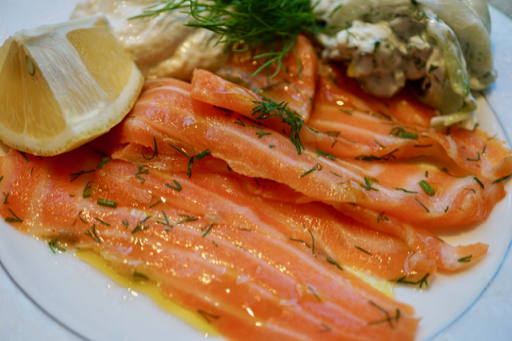The dish shown below was the first time we tasted my purchase. I made three different preparations but I did not take a picture of the third dish which was an imitation "negitro" ネギトロ.
After thawing the tuna block in the refrigerator (it took almost 2 days), I divided the block into three portions. One I made into "zuke" 漬け or marinated tuna. This time I used "concentrated noodle sauce めんつゆ from the bottle" plus ground roasted white sesame. I sliced the tuna and marinated the slices for several hours in the refrigerator. Just for variation, I seared half of the "Zuke" tuna (far right) using a kitchen torch. The yellow item shown on the plate below is "Dashimaki" だし巻き omelet I had made earlier. I placed the tuna sashimi on top of baby arugula. I also served "Ikura" salmon roe in a cucumber cup (upper left corner).
We really enjoyed this. This is about the same as the frozen yellowfin tuna blocks we buy at our Japanese grocery store. It may be slightly better since it seemed to contain less water. (After thawing, not much water came out). The textures and taste are about the same. The "Zuke" and "imitation negitoro" preparations made very good variations.
We really enjoyed this. This is about the same as the frozen yellowfin tuna blocks we buy at our Japanese grocery store. It may be slightly better since it seemed to contain less water. (After thawing, not much water came out). The textures and taste are about the same. The "Zuke" and "imitation negitoro" preparations made very good variations.





















































